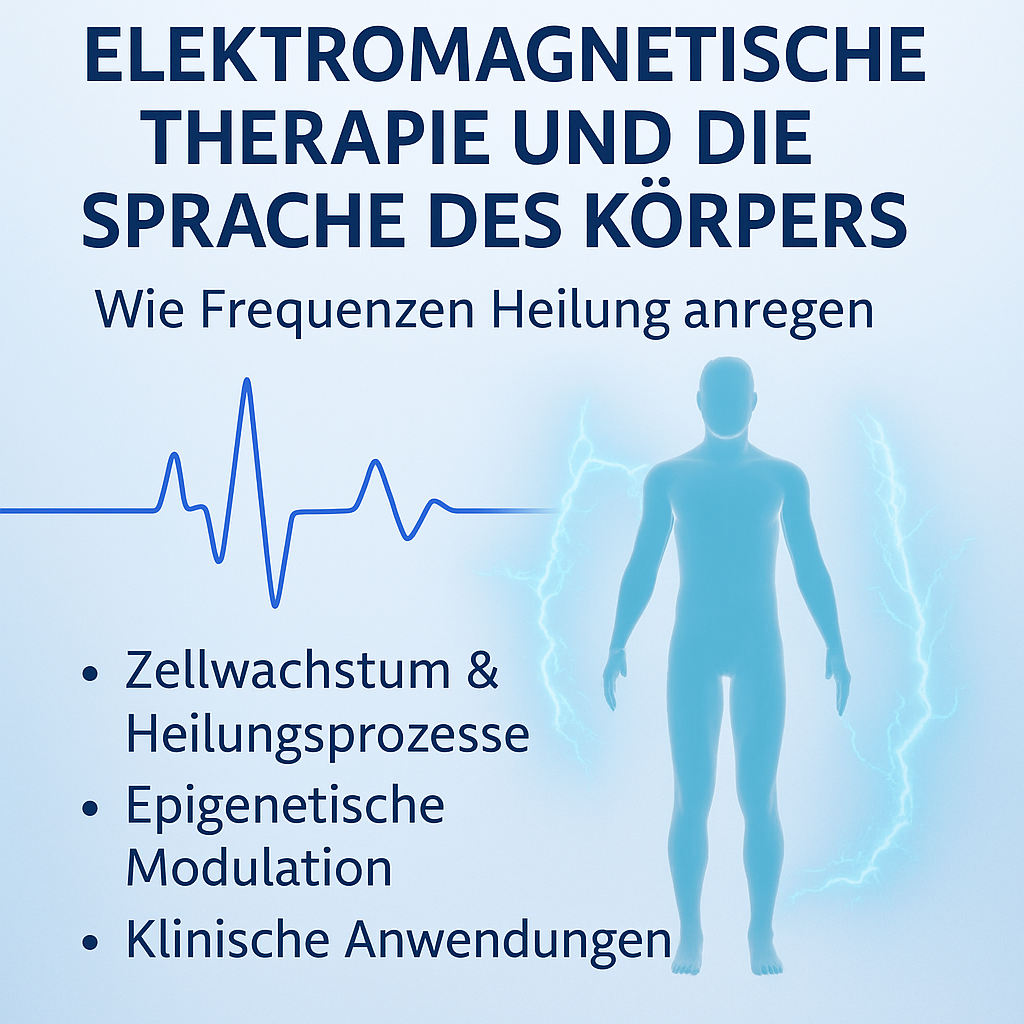
Electromagnetic therapy and the language of the body: how frequencies stimulate healing
Frequency therapy is far more than an esoteric concept. It is based on a solid biological foundation that reaches deep into the molecular and cellular organisation of our body. The publication by Prof. Dr Richard H.W. Funk from TU Dresden provides a comprehensive overview of the mechanisms by which electromagnetic fields (EMF) and pulsed electromagnetic fields (PEMF) interact with biological systems - and why they can be so valuable therapeutically.
1. Bioelectricity - the "invisible conductor" of cellular processes
Every cell in our body is electrically active. Ion gradients, created by transporters and pumps in the cell membrane, generate voltage differences that are not only essential for nerve conduction, but also:
- Control cell growth
- Enable the differentiation of stem cells
- Initiate healing processes
- Influence inflammatory reactions
These electrical fields are not by-products, but fundamental information systems with which cells communicate with each other. Science refers to this as endogenous bioelectricity.
2. Frequency therapy meets resonance: is there a biological counterpart?
The central question of the study is: Do externally applied EMF/PEMF meet corresponding biological structures?
The answer: Cells have numerous mechanisms for receiving electromagnetic stimuli:
- The resting potentials vary depending on the cell type and are in a delicate balance.
- Cancer cells or inflammatory tissue have a strongly altered electrical profile that can be modulated by EMF.
- Gap junctions (cellular ion bridges) enable the propagation of electrical impulses across large cell clusters.
Even small changes in the membrane potential can trigger gene regulatory processes - including epigenetic modulation.
3. Principles of action of electromagnetic fields in the body
The study describes several coupling mechanisms:
a) Faraday coupling
Magnetoelectric induction generates electric fields directly at cell membranes. These can influence ion channels, modulate the resting potential and thus trigger biological reactions.
b) Electroconformational coupling
Periodic fields change the structure of sensitive molecules, especially enzymes and receptors - this can accelerate and control biochemical reactions.
c) Stochastic resonance
A biological system can be made more sensitive to certain signals by so-called "white noise frequencies" - this makes it possible to amplify even weak impulses.
d) Genetic resonance
Genes such as HSP70 or c-myc react directly to electromagnetic signals through so-called EMF-responsive elements in their promoter regions.
4. Therapeutic applications: Clinical relevance of frequency therapy
The findings of this research are not purely theoretical. There are now numerous in vitro, animal and clinical studies that document the effectiveness of electromagnetic stimuli:
➤ Orthopaedics & regeneration
- Improved bone healing in fractures and tendon ruptures
- Increased osteogenesis through targeted PEMF application
osteoarthritis
- Reduction of joint pain, inflammation and cartilage degradation
- Positive influence on cartilage metabolism
➤ Neurology & neuropathies
- Improved regeneration of peripheral nerves (e.g. in diabetic polyneuropathy)
- Increased production of neurotrophic factors
➤ Wound healing
- EMF activates cell migration and stimulates the formation of new tissue
- Promotes re-epithelialisation after injuries
5. BioZapper, PEMF devices & vital field therapy: where do we stand today?
Thanks to modern devices (e.g. vital field systems), frequency therapy can now be used in a targeted and evidence-based manner. Important are:
- Frequency accuracy (e.g. 2-20 Hz for cell regeneration)
- Duration of application (often 10-30 minutes per session)
- Individual stimulation parameters depending on the symptoms
It is also becoming increasingly clear that trained therapists are needed who not only understand the device, but also the physiological principles.
6. Conclusion: Frequency therapy as a bridge between biophysics and biology
Frequency therapy does not use "just any" vibrations, but targeted stimuli that resonate with the body's electromagnetic control circuits. Today, research provides the models, measurements and biological evidence that electromagnetic stimuli can be used therapeutically - not as a substitute, but as a supplement to traditional methods.
Frequencies are not magic. They are a language that the body understands - and to which it reacts.
📚 Sources:
Funk, R.H.W. (2017). Does electromagnetic therapy meet an equivalent counterpart within the organism? Journal of Translational Science, 3(2), 1-6. DOI: 10.15761/JTS.1000175
